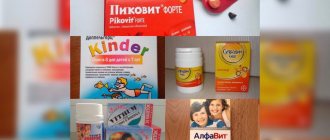Compound
active ingredient:
paracetamol;
5 ml of syrup contains 120 mg of paracetamol (based on 100% dry matter); Excipients:
methyl parahydroxybenzoate (E 218), propyl parahydroxybenzoate (E 216), propylene glycol, glycerin, ethanol 96%, sorbitol (E 420), raspberry flavor, Ponceau 4R (E 124), purified water.
Dosage form.
Syrup.
Basic physical and chemical properties:
transparent viscous liquid, pink in color with a sweet taste and characteristic aroma of raspberries.
Pharmacotherapeutic group.
Analgesics and antipyretics.
ATX code
N02B E01.
Pharmacological properties
Pharmacodynamics.
Exhibits analgesic and antipyretic effects. The mechanism of action is associated with inhibition of prostaglandin synthesis and an effect on the thermoregulation center in the hypothalamus.
Pharmacokinetics.
After oral administration, paracetamol is rapidly absorbed from the digestive tract, mainly in the small intestine, mainly by passive transport. After a single dose of 500 mg, the maximum concentration in the blood plasma is reached after 30-60 minutes. It is well distributed in tissues and mainly in body fluids, with the exception of adipose tissue and cerebrospinal fluid. Plasma protein binding is less than 10% and increases slightly with increasing dose. Sulfate and glucuronide metabolites do not bind to plasma proteins even in relatively high concentrations. Paracetamol is metabolized primarily in the liver by conjugation with glucuronides, conjugation with sulfates and oxidation with the participation of mixed liver oxidases and cytochrome P450. The hydroxylated metabolite with a negative effect N-acetyl-p-benzoquinoneimine, which is formed in very small quantities in the liver and kidneys under the influence of mixed oxidases and is detoxified by binding to glutathione, can accumulate during an overdose of paracetamol and cause tissue damage. In adults, most of paracetamol is bound to glucuronic acid and in smaller quantities to sulfuric acid. These conjugated metabolites do not exhibit biological activity. In premature babies, newborns and children in the first year of life, sulfate metabolism predominates. The half-life is 1-4 hours. In patients with liver cirrhosis, the half-life is slightly increased. The renal clearance of paracetamol is 5%. The drug is excreted in the urine, mainly in the form of glucuronic and sulfate conjugates. Less than 5% is excreted as unchanged paracetamol.
Clinical characteristics.
Paracetamol syrup 100ml BO
General characteristics: international and chemical names: paracetamol; N-(4-hydroxyphenyl)acetamide; basic physicochemical properties: transparent viscous liquid of pink color with a sweet taste and characteristic smell of raspberries; composition: 5 ml of syrup contains 120 mg of paracetamol; excipients: propylene glycol, glycerin, ethyl alcohol 96%, sorbitol, methyl parahydroxybenzoate, propyl parahydroxybenzoate, Raspberry food flavoring, Ponceau 4R, purified water.
Release form. Syrup.
Pharmacotherapeutic group. Analgesics and antipyretics. ATC code N02B E01.
Pharmacological properties. Pharmacodynamics . It has analgesic, antipyretic and weak anti-inflammatory effects. The mechanism of action is associated with inhibition of prostaglandin synthesis and an effect on the thermoregulation center in the hypothalamus. Pharmacokinetics . After oral administration, paracetamol is rapidly absorbed from the gastrointestinal tract, mainly in the small intestine, mainly by passive transport. After a single dose of 500 mg, the maximum concentration in the blood plasma is reached after 10-60 minutes and is about 6 μg/ml, then gradually decreases and after 6 hours it is 11-12 μg/ml. It is well distributed in tissues and mainly in body fluids, with the exception of adipose tissue and cerebrospinal fluid. Protein binding is less than 10% and increases slightly with increasing dose. Sulfate and glucuronide metabolites do not bind to plasma proteins even at relatively high concentrations. Paracetamol is metabolized primarily in the liver by conjugation with glucuronides, conjugation with sulfate and oxidation with the participation of mixed liver oxidases and cytochrome P450. The negative hydroxylated metabolite -N-acetyl-p-benzoquinoneimine, which is formed in very small quantities in the liver and kidneys by mixed oxidases and is usually detoxified by binding to glutathione, can accumulate during paracetamol overdose and cause tissue damage. In adults, most of paracetamol is bound to glucuronic acid and in smaller quantities to sulfuric acid. These conjugated metabolites do not have biological activity. In premature infants, newborns and in the first year of life, the sulfate metabolite predominates. The half-life is 1-3 hours. In patients with liver cirrhosis, the half-life is slightly longer. The renal clearance of paracetamol is 5%. The drug is excreted in the urine mainly in the form of glucuronide and sulfate conjugates. Less than 5% is excreted as unchanged paracetamol.
Indications for use. Pain syndrome of low and medium intensity of various origins (headache and toothache, neuralgia, muscle pain; pain during teething; with injuries; burns; pharyngitis, rheumatic pain). Fever in infectious and inflammatory diseases.
Method of administration and dose. The drug is prescribed orally. Single dose for children aged 6 months to 1 year – 60 – 120 mg of paracetamol (1/2 – 1 teaspoon of syrup), from 1 year to 3 years – 120 – 180 mg of paracetamol (1 -1.5 teaspoon spoons of syrup), from 3 to 6 years - 180 - 240 mg of paracetamol (1.5 - 2 teaspoons of syrup), from 6 to 12 years - 240 - 360 mg of paracetamol (2 - 3 teaspoons of syrup), over 12 years - 360 - 600 mg of paracetamol (3 - 5 teaspoons of syrup). The frequency of administration is 3-4 times a day with an interval between each dose of at least 4 hours. The maximum duration of treatment is 3 days.
Side effect. Nausea and epigastric pain may occur; allergic reactions (skin rash, itching, urticaria, Quincke's edema). Possible side effects such as hemolytic anemia, thrombocytopenic purpura, methemoglobinemia, agranulocytosis. With long-term use in doses exceeding therapeutic ones, hepatotoxic effects are possible.
Contraindications. Hypersensitivity to paracetamol and other components of the drug, severe dysfunction of the liver and kidneys, deficiency of glucose-6-phosphate dehydrogenase, blood diseases (severe anemia, leukopenia), children under 6 months of age. Congenital hyperbilirubinemia (Gilbert, Dubin-Johnson, Rotor syndrome).
Overdose. When taking syrup in doses higher than recommended, the following side effects are possible: hemolytic anemia, thrombocytopenic purpura; methemoglobinemia, agranulocytosis, hepatotoxic effect. In this case, gastric lavage is necessary, and, if possible, early administration of the antidote - acetylcysteine.
Features of application. Use with caution to treat patients with impaired liver and kidney function, with benign hyperbilirubinemia. Long-term use of anticonvulsants causes an increase in the activity of liver enzymes, which increases the intensity of the “first pass” effect through the liver and prolongs the clearance of the drug. This may prevent paracetamol blood levels from reaching therapeutic levels. With long-term use of the drug, monitoring of the peripheral blood picture and the functional state of the liver is necessary.
Interaction with other drugs. In patients who have taken phenytoin, rifampicin, barbiturates and tricyclic antidepressants, the half-life of paracetamol may be increased and the risk of hepatotoxicity may be increased. Increases the effect of indirect anticoagulants. Increases the toxicity of chloramphenicol.
Conditions and shelf life. Store out of reach of children, protected from light at a temperature not exceeding 25°C.
Best before date. 3 years. After opening the bottle, the shelf life of the drug is 30 days at a temperature of 20-25°C.
Vacation conditions. Over the counter.
Package. 50 ml or 100 ml in a glass bottle, 1 bottle in a pack; 50 ml or 100 ml in a polymer bottle, 1 bottle in a pack; 100 ml in a glass or polymer jar, 1 jar in a pack.
Contraindications
- Hypersensitivity to paracetamol and other components of the drug, especially parabens (methyl and propyl parahydroxybenzoate);
- severe dysfunction of the liver and kidneys (including liver and kidney failure);
- deficiency of glucose-6-phosphate dehydrogenase;
- blood diseases (including severe anemia, leukopenia);
- congenital hyperbilirubinemia (Gilbert, Dubin-Johnson, Rotor syndrome);
- alcoholism.
Interaction with other drugs and other types of interactions.
The drug should not be used simultaneously with other drugs that contain paracetamol
so as not to exceed the maximum daily dose of paracetamol.
When using paracetamol simultaneously with hepatotoxic drugs
the toxic effect of drugs on the liver increases.
Drugs that induce hepatic microsomal enzymes (including barbiturates, phenytoin, carbamazepine, primidone, other anticonvulsants, tricyclic antidepressants, oral contraceptives, St. John's wort), ethanol:
it is possible to increase the toxic effect of paracetamol on the liver due to an increase in the degree of conversion of the drug to hepatotoxic metabolites, especially when using high doses of paracetamol.
Barbiturates:
reducing the antipyretic effect of paracetamol.
Do not use simultaneously with ethanol
and with other drugs containing
ethanol
.
Probenecid, propanolol:
the effect of paracetamol may be enhanced.
Lixisenatide:
the absorption of paracetamol may be reduced when used 1-4 hours after taking lixisenatide.
Chloramphenicol:
increasing its toxicity, since the half-life of chloramphenicol is extended and its concentration in the blood plasma increases.
Metoclopramide, domperidone:
it is possible to increase the rate of absorption of paracetamol.
Cholestyramine:
the rate of absorption of paracetamol may be reduced.
Warfarin, other coumarins:
the anticoagulant effect may be enhanced with an increased risk of bleeding when using high doses of paracetamol for several days; Regular monitoring of the International Normalized Ratio (INR) is recommended; single doses of paracetamol have no significant effect. If necessary, the dose of the oral anticoagulant should be adjusted during treatment with paracetamol.
Diflunisal and other NSAIDs:
Serum paracetamol levels increase, increasing the risk of hepatotoxicity and nephrotoxicity.
Isoniazid, rifampicin, other hepatotoxic drugs:
increased risk of developing hepatotoxic syndrome.
Diuretics:
paracetamol reduces their effectiveness.
Antiviral drugs:
Regular use of paracetamol may reduce the metabolism of zidovudine (increased risk of neutropenia).
Interaction with diagnostic tests:
paracetamol may affect the results of determining uric acid in the blood when using the phosphotungstic acid method and determining blood glucose using the oxidase-peroxidase method.
Indications and contraindications
Paracetamol suspension for children, the instructions confirm this, is prescribed to lower temperatures and relieve mild pain in various infectious and inflammatory diseases. In addition, the children's drug in the form of a suspension is suitable as an anesthetic for toothache, in particular it is used during teething. It is also indicated for relieving headaches. When used, the child’s condition is normalized when ear pain occurs due to otitis media. The medicine alleviates the condition of children with sore throat.
Intended as an antipyretic and analgesic for use from 3 months. It is allowed to continue using it for its intended purpose for up to 12 years. At the age of up to 3 months, a single dose is allowed when post-vaccination hyperthermia appears. If the temperature cannot be brought down, repeated use is prohibited and a pediatrician’s consultation is required.
An absolute contraindication is individual intolerance to the active substance. The drug for children is not prescribed until the baby is one month old. It is necessary to refuse the drug for various blood diseases. The suspension should not be taken in combination with other drugs that contain paracetamol.
Application Features
It should not be used simultaneously with other medicines containing paracetamol used, for example, to reduce fever, treat pain, flu and cold symptoms, and insomnia. Concomitant use with other drugs containing paracetamol may lead to an overdose. An overdose of paracetamol can cause liver failure, which may lead to the need for a liver transplant or death.
Before using the drug, you should consult your doctor.
Do not exceed the recommended dose and duration of treatment.
The maximum duration of use without consulting a doctor is 3 days.
If symptoms of the disease persist or worsen, you should definitely consult a doctor.
Patients taking daily analgesics for mild arthritis should consult a doctor before using the drug. When treating with paracetamol at a dose of 60 mg/kg/day, the concomitant use of another antipyretic is justified only if paracetamol is insufficiently effective.
Before using paracetamol, you should consult your doctor if the patient is taking warfarin or similar drugs that have an anticoagulant effect.
Use with caution in patients with liver and kidney diseases (for these diseases, you should consult a doctor before using the drug. It should be taken into account that in patients with liver diseases, including alcoholic non-cirrhotic liver damage, the risk of hepatotoxic action of paracetamol increases.
Liver dysfunction/liver failure has been reported in patients with low glutathione levels, for example, severe malnutrition, anorexia, low body mass index or chronic alcoholism. In patients with decreased glutathione levels, for example in severe infections such as sepsis, the risk of metabolic acidosis increases when taking paracetamol. Symptoms of metabolic acidosis include deep, rapid or labored breathing, nausea, vomiting, and loss of appetite. You should consult a doctor immediately if these symptoms occur.
With long-term use of the drug, monitoring of the composition of peripheral blood and the functional state of the liver and kidneys is necessary (the role of paracetamol has not been completely excluded in the development of nephropathy associated with the use of analgesics).
The drug contains sorbitol (E 420), therefore patients with rare hereditary fructose intolerance should not use this drug. It may also cause a slight laxative effect.
The drug contains ponceau 4R (E 124), methyl parahydroxybenzoate, propyl parahydroxybenzoate, which can cause allergic reactions (possibly of a delayed type).
The drug contains ethanol (alcohol) (in 5 ml of syrup - 125 mg of 96% ethanol). Harmful for patients with alcoholism. Caution should be exercised when used by pregnant and breastfeeding women, children and patients with liver disease and epilepsy.
The drug may affect the results of laboratory tests of blood glucose and uric acid levels.
Use during pregnancy or breastfeeding.
There are no standardized studies using currently accepted standards for assessing reproductive and developmental toxicity.
A large amount of data on the use of paracetamol drugs in pregnant women does not indicate either malformative or feto/neonatal toxicity. Epidemiological studies of the neurodevelopment of children exposed to paracetamol in utero show inconclusive results. If paracetamol is clinically necessary, it can be used during pregnancy, but at the lowest effective dose for the shortest possible duration and at the lowest possible frequency of use.
This dosage form is used for children.
The ability to influence the reaction rate when driving vehicles or other mechanisms.
This dosage form is used for children.
How much to give Paracetamol tablets to children?
The dosage of the medication depends on the weight and age of the child. Children aged 2 months to 15 years are recommended to take 10-15 mg of the drug per 1 kg of weight in one dose. The daily dose, as a rule, does not exceed 60 mg per kilogram of weight. The drug begins to act within 30 minutes, sometimes after an hour. It is recommended to take the product every 6 hours, no more than 4 times a day. It is not recommended to give Paracetamol to children more often, as this will lead to an overdose.
Be careful when choosing an antipyretic drug for your child, strictly follow the doctor’s recommendations and the instructions in the instructions for the drug. Be healthy!
Paracetamol, which has long been known and has repeatedly demonstrated its miraculous power, is often the culprit of severe poisoning in children under school age. The mothers and fathers of the other kids are seriously worried: can children have paracetamol? What safety precautions does this drug require? Is there a worthy replacement for pills?
Directions for use and doses
The drug is intended for oral use only. The dose of paracetamol for all children is calculated depending on age and body weight. The lowest dose of the drug necessary to obtain a therapeutic effect should be used.
A single dose of paracetamol is 10-15 mg/kg body weight. The maximum daily dose of paracetamol is 60 mg/kg body weight.
The drug can be repeated every 4-6 hours if necessary. Do not take more than 4 doses in 24 hours. The interval between doses should be at least 4 hours. The maximum course of treatment without consulting a doctor is 3 days.
Children from 6 months to 12 years.
In the table you should find the dose corresponding to the child’s age. Measure the dose of the drug using a dosing spoon, which has marks of 2.5 ml and 5 ml.
Single doses of paracetamol syrup 120 mg/5 ml for children
| Age | Dose |
| 6-24 months | 5 ml |
| 2-4 years | 7.5 ml |
| 4-8 years | 10 ml |
| 8-10 years | 15 ml |
| 10-12 years | 20 ml |
Children.
The drug is contraindicated for use in children under 6 months. This dosage form is for use in children aged 6 months to 12 years.
How to give paracetamol to children?
The drug is a white powder with a slight tint. It dissolves in alcohol, but not in water. How to take paracetamol tablets correctly for the treatment of children? The medicine is used when the temperature on the thermometer is more than 38° C. Each age group has its own conditions for administration and dosage calculation. For a small child, 10-15 mg of active substance per kilogram of weight is enough. Babies up to one year old are given syrup or suspension. Suppositories can be used for infants after three months; the dosage is determined by the doctor in each specific case.
The tablet form is contraindicated for children under 3 years of age, and not recommended for children under 6 years of age. For the age group from 3 to 6 years, you can take one tablet (200 mg) at a time. Children with low weight can be given half a tablet. Children after six years old can take 1.5-2 pills. From 6 to 12 years old, one tablet is prescribed, the dosage of paracetamol is 350 mg. Children over 12 years of age are given 500 mg of paracetamol.
The frequency of administration is no more than four times a day, with an interval of 4 hours.
Avoid overdosing on medication. If the temperature does not decrease, the pill can be given again only after 4-5 hours.
How to take the drug if the child cannot swallow the pill? For babies, it can be crushed by adding a small amount of water. Take the drug 2 hours after meals. The drug is prescribed for no more than 3 days, for children under 6 years of age, for older children, treatment can be extended up to 5 days. When giving paracetamol to children, the dosage of the drug in tablets must be correctly calculated. Proportions must be observed so as not to harm the baby’s body weakened by the disease.
Overdose
Liver damage is possible in adults who took 10 g or more of paracetamol, in children who took more than 150 mg/kg body weight.
In patients with risk factors, use of 5 g or more of paracetamol may cause liver damage. An overdose of paracetamol can cause liver failure, which may lead to the need for a liver transplant or death.
Risk factors:
- long-term treatment with carbamazepine, phenobarbital, phenytoin, primidone, rifampicin, St. John's wort or other drugs that induce liver enzymes;
- regular excessive consumption of ethanol;
- glutathione cachexia (digestive disorders, cystic fibrosis, HIV infection, hunger, cachexia).
Symptoms
overdose in the first 24 hours: pale skin, nausea, vomiting, anorexia and abdominal pain, increased activity of “liver” transaminases and increased prothrombin index. Liver damage may become apparent 12 to 48 hours after overdose. Impaired glucose metabolism and metabolic acidosis, hepatocellular failure, and hepatonecrosis may occur. In severe poisoning, liver failure may progress to hypoglycemia, encephalopathy, hemorrhage, cerebral edema, coma and death.
Acute renal failure with acute tubular necrosis, accompanied by severe low back pain, hematuria and proteinuria, can develop even in the absence of severe liver damage.
When using high doses, the following are possible:
- from the nervous system - dizziness, psychomotor agitation or depression of the central nervous system, disturbance of orientation and attention, insomnia/drowsiness, tremor, nervousness, anxiety, impaired consciousness, hyperreflexia, convulsions;
- from the urinary system - nephrotoxicity (renal colic, interstitial nephritis, papillary necrosis).
In case of overdose, cardiac arrhythmia (including tachycardia, extrasystole) and pancreatitis, which is usually accompanied by impaired liver function and hepatotoxicity, and increased sweating, may develop.
With long-term use of high doses, the development of aplastic anemia, thrombocytopenia, pancytopenia, agranulocytosis, neutropenia, leukopenia is possible.
Treatment.
In case of overdose (even in the absence of symptoms), emergency medical care and immediate hospitalization are required. Symptoms may be limited to nausea or vomiting and may not be consistent with the severity of overdose or the risk of organ damage.
Plasma paracetamol concentrations should be assessed 4 hours or later after administration (earlier concentration determinations are not reliable).
In the first hour after taking a large dose of paracetamol, it is necessary to rinse the stomach, induce vomiting, and apply activated charcoal.
Treatment with acetylcysteine should be used within 24 hours after taking paracetamol, but the maximum protective effect is observed when it is used within 8 hours after overdose. The effectiveness of the antidote decreases sharply after this period. Acetylcysteine should be administered intravenously according to the established dosage regimen. In the absence of vomiting, oral methionine may be used as an appropriate alternative in areas away from the hospital.
It is also necessary to carry out symptomatic measures.
Side effects
The immune system:
hypersensitivity reactions and anaphylactic reactions, incl. rash on the skin and mucous membranes (usually a generalized rash, erythematous, urticaria is possible due to the presence of methyl and propyl parahydroxybenzoates in the drug), itching, angioedema, exudative erythema multiforme (including Stevens-Johnson syndrome), toxic epidermal necrolysis (syndrome Lyell). If a rash occurs, you must immediately stop taking the drug.
Respiratory system:
bronchospasm in patients sensitive to acetylsalicylic acid and other NSAIDs.
Nervous system
(usually develops when using high doses): dizziness, psychomotor agitation, disorientation.
Digestive system:
nausea, epigastric pain, impaired liver function, increased activity of “liver” enzymes in the blood serum, usually without the development of jaundice, hepatonecrosis (dose-dependent effect); Cases of acute pancreatitis have been reported (usually in overdose). The drug contains sorbitol, which can cause a mild laxative effect.
Endocrine system:
hypoglycemia, possible development of hypoglycemic coma.
Blood and lymphatic system:
anemia, sulfhemoglobinemia and methemoglobinemia (cyanosis, shortness of breath, heart pain), hemolytic anemia. With long-term use in doses exceeding therapeutic ones - aplastic anemia, pancytopenia, thrombocytopenia, which can cause bruising, bleeding, incl. nosebleeds and/or bleeding gums, leukopenia, neutropenia, agranulocytosis.
Urinary system:
when using high doses - nephrotoxic effect (renal colic, interstitial nephritis, papillary necrosis), aseptic pyuria.
Side effects when using paracetamol are rare and depend on the dose and duration of use of the drug.
If any side effects occur, you must immediately stop using the drug.










